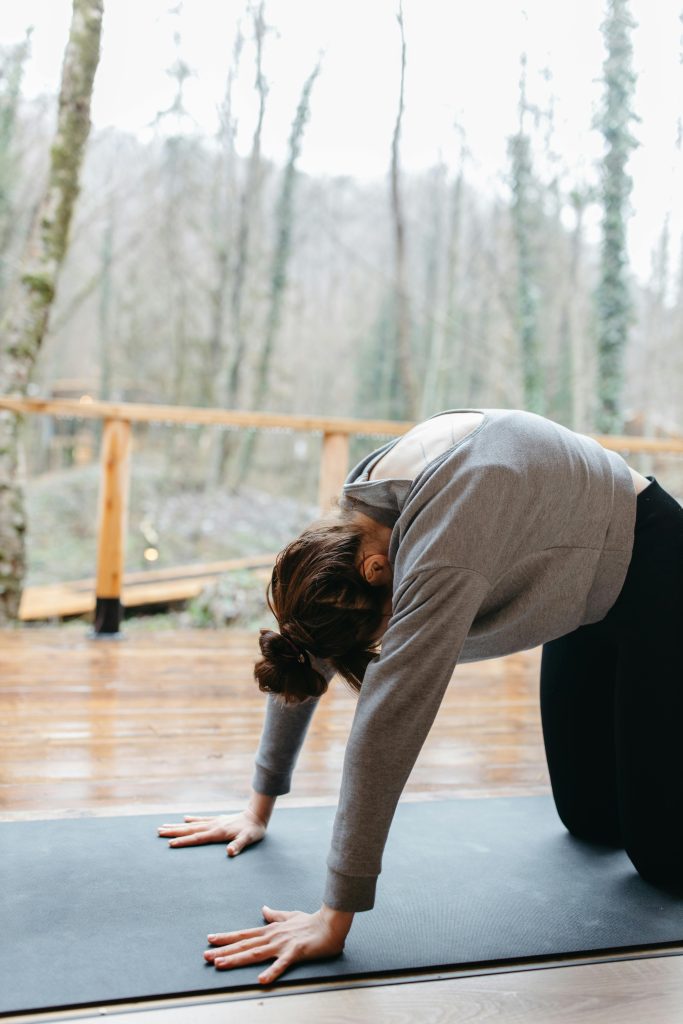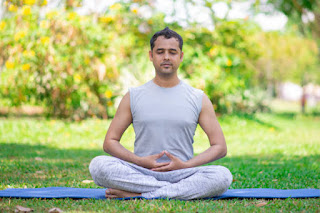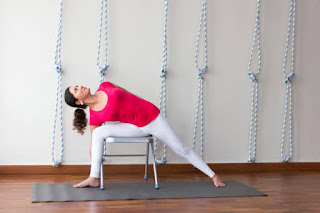Yoga for Deep Fascia Release: Unlocking Tension in the Body

Introduction: Why Fascia Matters for Your Body and Mind
For many people, a yoga journey begins with the hope of improving health — usually through greater flexibility, stress relief, or pain management. But one of the biggest reasons students drift away from yoga is frustration: they don’t see the results they expected. Despite regular practice, they still wake up stiff, tense, and achy.
What if the problem isn’t your muscles at all, but something deeper? The real culprit could be your fascia — the hidden web of connective tissue that wraps around every muscle, organ, and joint in your body. When fascia becomes tight, dehydrated, or “stuck,” it can create tension and limit mobility, no matter how much you stretch.
This is where yoga truly shines. With mindful movement, breathwork, and long-held poses, yoga offers one of the most effective ways to support fascia release. By targeting this deeper layer of the body, yoga doesn’t just improve flexibility — it can help you unlock tension, restore energy, and reconnect with a sense of freedom in your body.
In this article, we’ll explore what fascia is, why it holds the key to lasting flexibility, and how yoga and simple daily habits can transform your fascia health.
What is Fascia? The Body’s Hidden Web
At its core, fascia is a type of connective tissue that holds the entire body together. It surrounds and supports your muscles, bones, nerves, blood vessels, and even your organs. Made primarily of collagen, fascia has a fibrous yet stretchy quality that forms continuous layers throughout the body — like a three-dimensional web.
There are three main types of fascia, each with its own role:
- Superficial fascia – lies just beneath the skin, connecting skin to muscle and storing fat and fluid.
- Deep fascia – wraps tightly around muscles, bones, blood vessels, and nerves, providing structure and stability.
- Visceral fascia – surrounds and supports the organs, holding them in place within the body.
That’s the science. But many holistic traditions go a step further, describing fascia as the “fabric of consciousness.” Because fascia is highly sensitive and full of nerve endings, some believe it stores not just physical tension but also emotional memory and energy. This is why a deep stretch or yoga pose can sometimes bring unexpected feelings of release — your fascia is letting go on more than one level.
When your fascia is healthy, you move with freedom, ease, and flow. When it becomes stiff or dehydrated, you may feel restricted, heavy, or even “stuck” in your body. Supporting fascia health through mindful movement, hydration, and yoga practices can unlock both physical and emotional flexibility.
Signs Your Fascia Needs Care
- Common symptoms: chronic stiffness, poor mobility, unexplained aches, postural imbalances.
- Emotional signs: stress stored in the body, feeling blocked or heavy.

Yoga for Fascia Release: Why It Works So Well
How do you know if your fascia is unhealthy or in need of attention? Unlike muscles, which often feel sore after a workout, fascia problems can be harder to pinpoint. Still, there are clear warning signs to watch for.
Common physical symptoms of fascia tightness include:
- Chronic stiffness, especially in the morning
- Limited or poor mobility despite regular stretching
- Unexplained aches or tension patterns that don’t improve with rest
- Postural imbalances, such as rounded shoulders or a tight lower back
But fascia isn’t just physical — it’s deeply connected to how we feel. Many people notice emotional signs of unhealthy fascia, such as:
- A sense of heaviness or being “weighed down” in the body
- Stress or anxiety that seems stored in the muscles
- Feeling emotionally blocked or stuck, especially during deep stretches
If any of these resonate with you, your body may be signaling that it’s time to care for your fascia. The good news? Practices like yoga, mindful movement, hydration, and self-massage can help restore fascia health and bring relief.
Best Yoga Poses for Deep Fascia Release
Best Yoga Poses for Fascia Release
Below is a simple yoga flow designed to support fascia release and unlock tension in the body. Move at a comfortable pace, letting your breath guide each transition. The goal is not to raise your heart rate but to soften and hydrate your fascia through slow, mindful movement.
You can cycle through this sequence multiple times depending on how much time you have. If you’re more experienced with yoga, feel free to explore variations of each pose to deepen your fascia release.
1. Cat-Cow Flow (Hydrating the Spine)
Move gently between arching and rounding your back, syncing movement with breath. This mobilizes the spine and hydrates the surrounding fascia.
2. Forward Fold with Gentle Bounce (Releasing the Back Line)
Fold forward from the hips and allow a soft, micro-bounce in the knees. This loosens the fascia along the hamstrings, calves, and spine.
3. Lizard Pose (Opening Deep Hip Fascia)
Step one foot forward into a low lunge with hands on the ground. Sink into the hips to target fascia in the hip flexors and inner thighs.
4. Supported Bridge (Front Body Release)
Lie on your back with feet flat, lifting the hips into a gentle bridge. Use a block or cushion for support. This opens fascia in the chest, abdomen, and front body.
5. Supine Twist (Detox + Energy Flow)
From lying on your back, drop one knee across the body into a gentle twist. This wrings out tension and supports fascia release through the spine and torso.
Practice this sequence slowly and mindfully, breathing deeply in each posture. With consistency, yoga for fascia health can improve flexibility, reduce stiffness, and restore a sense of flow throughout your body.
Beyond the Mat: Daily Fascia Health Habits
Stay Hydrated
Your fascia is made up of nearly 70% water, which means hydration plays a direct role in how well it functions. When fascia is well-hydrated, it remains supple, elastic, and resilient—allowing your muscles and joints to move freely. But when fascia becomes dehydrated, it can dry out, turn sticky, and lose its ability to glide. This stiffness often shows up as tension, aches, or a feeling of being “stuck” in your body. Simply put: hydrated fascia equals healthy, pain-free movement.
How to Stay Hydrated for Healthy Fascia
Most people think hydration is just about drinking more water, but fascia hydration requires more strategy.
- Sip, don’t chug – Drinking small amounts throughout the day helps your tissues absorb water more effectively.
- Balance electrolytes – Minerals like sodium, potassium, and magnesium improve how your fascia cells take in water. Try adding leafy greens, cucumbers, coconut water, or a pinch of mineral-rich sea salt to your diet.
- Eat water-rich foods – Fruits and vegetables such as watermelon, oranges, celery, and cucumbers offer hydration plus natural minerals that support fascia health.
By focusing on steady hydration and mineral balance, you’re not just drinking water—you’re actually helping your fascia absorb and use it.
Hydrating Fascia Through Movement
Water doesn’t simply soak into fascia on its own—it needs movement to be distributed. Think of fascia like a sponge: it draws in fresh water when squeezed and released.
- Dynamic stretching and mobility work help fascia tissues take in hydration and release built-up waste.
- Fascial rolling with a foam roller or therapy balls stimulates fluid flow through connective layers, easing stiffness.
- Breathwork practices encourage circulation, helping hydration move into deeper fascial networks.
By combining proper hydration habits with mindful movement, you create the ideal environment for healthy, hydrated fascia that supports flexibility, resilience, and overall well-being.
Move and Bounce Daily
Your fascia thrives on movement. Unlike muscles, fascia doesn’t stay healthy through strength alone, it needs variety, elasticity, and gentle bouncing to stay supple. Science shows that when you move in different directions, stretch dynamically, and add light, springy motions, fascia absorbs hydration better and maintains its natural glide. Think of it as “lubricating” your connective tissue.
On a more energetic level, bouncing, shaking, and playful movement can help release stagnant energy stored in the body. Many people find that a few minutes of light shaking feels not only physically freeing but also emotionally uplifting. It’s a simple way to shake off stress, reset your nervous system, and feel lighter.
Whether it’s jumping on a rebounder, dancing around your living room, or adding gentle bounces to your yoga practice, daily movement keeps fascia healthy, hydrated, and alive with energy. The key is consistency, just a few minutes a day can unlock stiffness and restore flow.
Posture Awareness
Your posture is more than just the way you sit or stand, it’s the blueprint your fascia follows. Fascia is highly adaptive. When the body spends hours slouched at a desk, hunched over a phone, or carrying tension in the shoulders, fascia slowly molds itself around that stress pattern. Over time, these imbalances don’t just affect how you look, they influence how freely you can move and how much energy you feel day to day. Science calls this “fascial remodeling” your connective tissue adaptively reshapes itself to match the demands you place on it.
On a more subtle level, posture can also be a reflection of your inner world. The phrase “your body holds your story” is deeply true when it comes to fascia. A collapsed chest may echo years of guarding the heart. Tight hips might reflect unexpressed emotions or stress the body never fully processed. This doesn’t mean posture causes emotions, but it does suggest a powerful feedback loop: how you carry yourself influences how you feel, and how you feel influences how you carry yourself.
Bringing awareness to posture isn’t about rigidly holding a “perfect” position, it’s about cultivating balance, openness, and flow. Throughout the day, notice when you begin to collapse inward, clench your jaw, or round your shoulders. Gently reset. Imagine lifting up through your spine, broadening your chest, and rooting down through your feet. Small corrections, repeated often, gradually reshape fascia in a healthier direction.
When posture awareness becomes part of your daily life, fascia begins to unwind old stress patterns and create space for new ones. The result? A body that not only moves with more ease but also reflects greater confidence, openness, and resilience.
Nutrition for Fascia
Fascia is mostly made of collagen, which means what you eat has a direct impact on how flexible, resilient, and hydrated your body feels. If you’ve ever struggled with lingering stiffness or tension that doesn’t seem to go away, pairing movement with the right nutrition can make all the difference. Think of it as feeding and watering the connective web that holds you together.
Collagen & Vitamin C
Collagen is the main protein that builds fascia. While your body makes its own, it needs the right building blocks. Foods rich in natural collagen—like bone broth, slow-cooked meats, or collagen peptide powders—can support tissue repair. Pair these with vitamin C–rich foods (citrus, bell peppers, strawberries, kiwi) since vitamin C is essential for collagen production. A simple smoothie with berries and a scoop of collagen powder is a fascia-friendly daily habit.
Minerals for Structure
Trace minerals like zinc (pumpkin seeds, oysters, beans), copper (nuts, seeds, shellfish), and manganese (leafy greens, whole grains) act like the “tools” your body uses to weave and maintain strong connective tissue. Getting a variety of colorful, whole foods ensures your fascia gets what it needs to stay strong and springy.
Hydration & Anti-Inflammatory Foods
Fascia is like a sponge—it needs water to stay supple. Alongside drinking water, eat hydrating foods such as cucumbers, watermelon, and leafy greens. Anti-inflammatory foods like salmon, walnuts, turmeric, and blueberries help protect your fascia from breakdown, making it easier to move with ease.
On a deeper, more subtle level, nourishing your fascia can feel like feeding your “inner web of light.” When your body is supported with the right nutrients, not only does tension ease, but you also feel more grounded, open, and energized from within.
Adding these simple nutrition tips to your daily routine—alongside the deep releasing yoga flow—creates a powerful self-care practice that supports both body and mind.
Fascia, Energy, and Emotional Release
Have you ever noticed unexpected emotions surface during a deep stretch or long yoga hold? That’s not unusual, it’s part of the way fascia interacts with both body and mind. Science shows that fascia is richly connected to the nervous system. When stress or trauma creates chronic tension, fascia can become tight, dehydrated, and less responsive. Many people describe this as carrying stress “in the shoulders” or feeling “heaviness” in the hips.
On an energetic level, fascia is often seen as the fabric through which life force flows, whether you call it prana in yoga, qi in Chinese medicine, or simply vitality. When fascia is restricted, energy can feel blocked. When it’s released, people often report not just physical ease but also emotional freedom. This is why stories of tears, laughter, or a deep sense of calm surfacing during long yin yoga poses or fascia release practices are so common. It’s the body letting go of what it no longer needs.
Yoga offers a safe, supportive way to explore this. Gentle holds, mindful breathing, and intentional awareness can unlock deep fascia and invite emotional release. For some, it feels like dissolving old patterns of stress. For others, it’s a powerful reset that restores energy and clarity.
By combining the science of fascia with the wisdom of spiritual traditions, we see the whole picture: fascia isn’t just tissue, it’s a bridge between body, mind, and energy. When you care for it, you’re not only improving mobility and reducing pain, you’re also opening pathways for emotional healing and inner flow.
Conclusion: Unlock Your Body’s Hidden Freedom
Fascia is more than connective tissue. It’s a living, adaptable web that responds to movement, breath, nutrition, and mindful awareness. It’s trainable, changeable, and vital to your overall health, flexibility, and energy flow. By caring for your fascia, you’re addressing tension at its root, supporting mobility, and creating space for emotional and energetic release.
Start small: try the deep fascia-releasing yoga sequence outlined above, and add just one daily habit, whether it’s a few minutes of bouncing, a posture reset, or a fascia-friendly snack. Even these tiny steps help your fascia loosen, hydrate, and regain resilience.
Remember: your fascia is your inner web. Nurture it, and your whole being softens and expands. With consistent attention, yoga, hydration, mindful movement, and nourishing food, you can unlock tension in the body and experience a new level of freedom in both movement and life.





